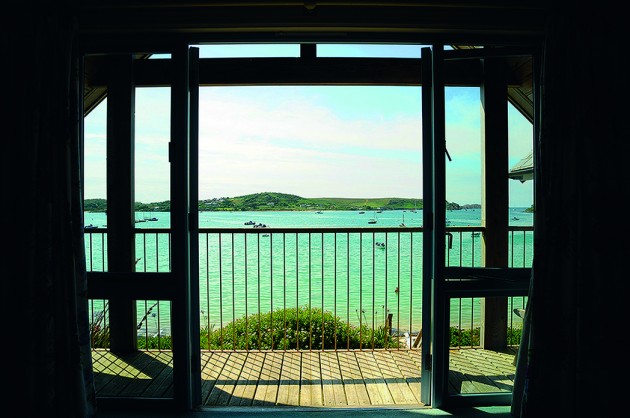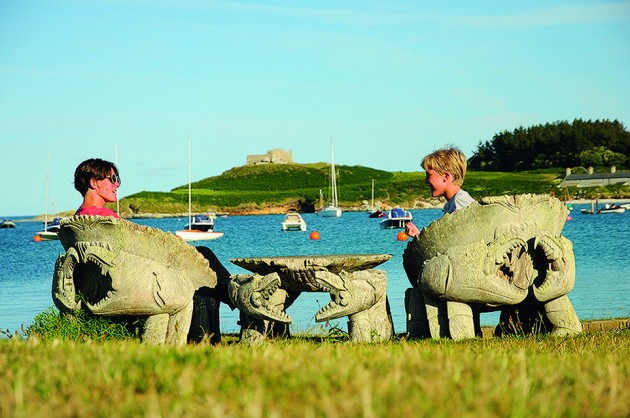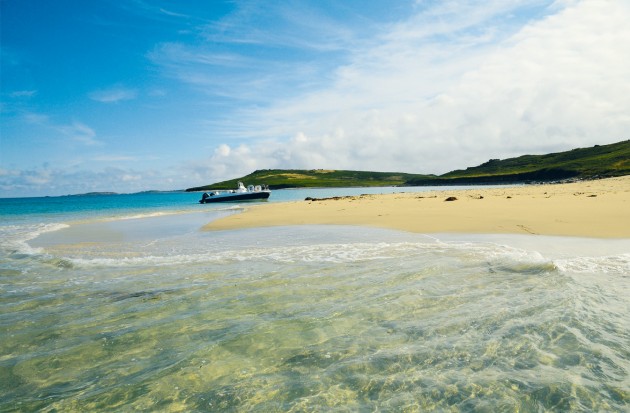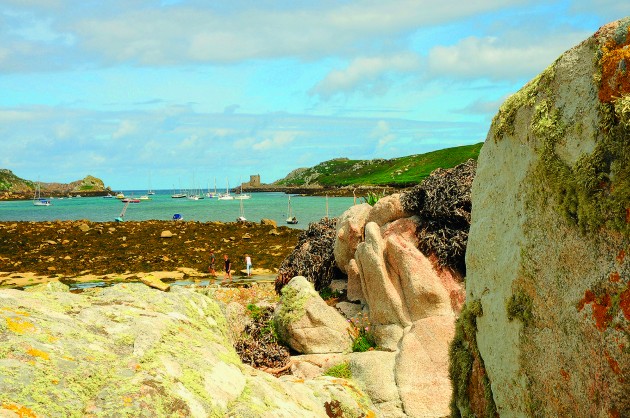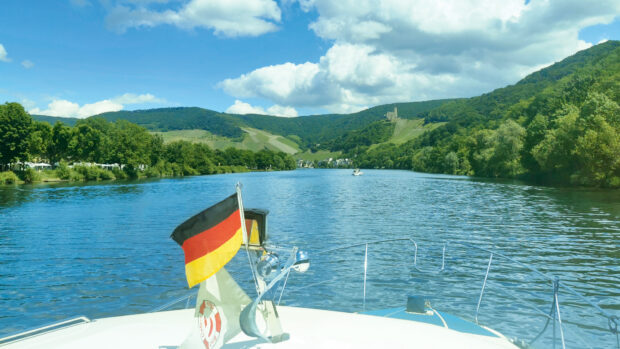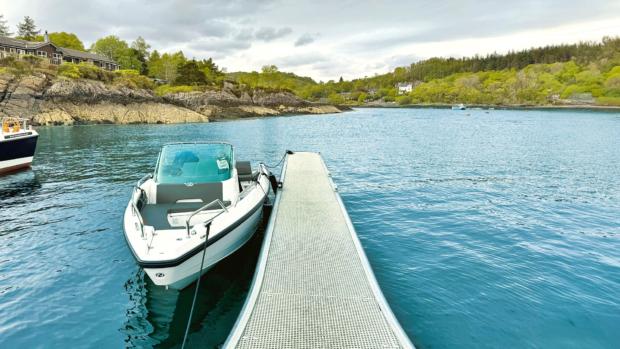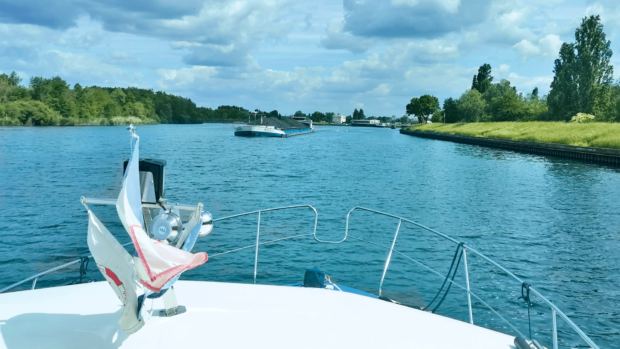Editor Hugo Andreae charters a Powercat 525 to explore the islands off the coast of the West Country
Okay, I’ll admit it, I cheated. For years I have dreamt about taking my own boat to the Isles of Scilly but the reality of towing a 23ft Karnic down to Penzance and hoping the weather would be kind enough to permit the 30-mile crossing to St Mary’s was just a little too daunting to risk gambling a precious week’s holiday on. So I did what any sensible bloke who values their marriage would do and booked flights, a holiday house and, most importantly of all, a boat, for a long weekend instead.
We might miss out on the satisfaction of cruising there under our own steam but at least we’d get there and frankly, looking out the window of our tiny 15-seat Skybus at the rash of jagged rocks littering the approach to the main islands, I’m quietly relieved someone else is at the helm. It’s not as if the public transport option is short of adventure – by the time we reach our final destination, a beautiful New England style beach house on the island of Tresco, we have already ridden in a car, a plane, a minibus, a jet RIB and a tractor trailer. The Scillies may only be a few dozen miles off Cornwall but already it feels like we’re a thousand miles and half a century away from ‘normal’ life.
Exploring the Scillies
The island vibe is unmistakable. With no cars, life instantly assumes a slower pace where legs, bicycles and a handful of golf carts are quite quick enough to propel you around Tresco’s tiny network of roads. But it’s not the land transport I’m interested in, it’s the Powercat 525 which I’ve been loaned from Bryher Boatyard. Moored directly in front of our cottage, it looks immaculate but worryingly small for navigating these infamous waters. The company’s proprietor Richard Drew reassures me that it was designed specifically for these islands and, before we head off for a quick lap of the island, takes pride in pointing out its shallow draught, reinforced hulls and the separate fuel and electrical systems for the twin 40hp outboard engines.
It’s wonderfully sheltered in New Grimsby Sound, the narrow stretch of water separating Tresco from the neighbouring island of Bryher, and there are already a fair few yachts from the mainland moored up along the fringes of the channel, including a lone Broom motor boat swinging from a visitor’s buoy. The water is so clear that the countless rocks strewn around the sea bed look like they are only a couple of feet below us. Richard assures me they are in fact three or four metres beneath our props but shows me how to look out for the darker patches of water and surface patterns, which indicate weed growth from a rocky outcrop closer to the surface. I’m less convinced by his insistence that the multitude of rocks are a good thing, “because it means you have to keep an eye out at all times,” but it certainly adds a frisson to boating in the area.
He shows me how to weave around the posts and slip over the flats past the southern tip of Tresco before ducking back in towards the sandy bay leading up to Tresco’s famous Abbey Gardens. Right on cue a seal pokes its head above water to see who’s invading its patch before getting back to hunting for its next meal.
Then it’s a quick zip across St Mary’s Road into St Mary’s Pool, the main harbour of the capital Hugh Town, before picking up a leading line back towards the east coast of Tresco and out into the unprotected waters of the Atlantic beyond its rocky northern coastline. Once outside this inner ring of islands, the sea takes on a very different demeanour with a substantial swell rolling in even on this calm July day.
The Powercat 525 belies its size, zipping gamely up the rollers before charging down the troughs far more confidently than many monohulls twice its size. Nevertheless I’m quietly relieved when we duck back in past Cromwell’s Castle and the ominously named Hangman’s Island to rejoin the shelter of New Grimsby Sound. Richard’s laid-back nonchalance – “you should see what it’s like in a real blow” – is strangely reassuring, although the knowledge that there are more shipwrecks per square mile in the Scillies than any other place on earth still lingers at the back of my mind. I choose not to share this with my wife Becca and 11-year-old son Ned.
Where to eat in the Scillies
By the time I return to our beach house, they’ve already made their own tour of the island on bicycles, including a quick trip to Tresco Stores (almost as well stocked as the supermarket of similar name, but far more personable) and are now eyeing up the menu of the Flying Club bistro a few steps from our front door. Becca and I opt for locally caught crab salad while Ned goes for a steak sandwich, all of which are accompanied by irresistibly crispy french fries.
It’s not just the food that’s overflowing with taste; our house is beautifully designed and decorated, the indoor swimming pool and spa we have access to could belong to a five-star country hotel, and even the solitary New Inn pub and Ruin Beach café on the other side of the island look like sets from a Boden catalogue. That’s because the whole Tresco estate is run by the Dorrien-Smith family on a long lease from the Duchy of Cornwall and nothing is left to chance.
It’s a strangely archaic, almost feudal system, but also a benign and undeniably effective one. Doors are left unlocked, bicycles are left unchained and I’m even instructed to leave the keys in the boat’s ignition. There is no crime – after all, where are you going to go on a 17ft open boat?
We pay for lunch using our Flying Boat credit card – every rental property has its own account which you settle up at the end of your stay – and head back to the house. The sun is still out and I’m keen to take the boat across to a particularly beautiful beach I caught a glimpse of on the uninhabited island of Samson around half a mile south of Bryher. Even from a distance I could see the almost Caribbean hue of the turquoise water lapping against the bright white sand.
Enjoying the Scilly Isles
We bundle into the small inflatable at the foot of the steps leading down from our cottage to the beach and row out the 20 yards to our mooring. Picking our way out through the visiting yachts past Plumb Island, I wait until we’re out in clear water before opening up the throttles and skimming through the gap between Yellow Rock and Puffin Island towards the beckoning beach on the north-eastern corner of Samson. The currents here have dragged the sand out into a shallow spit and we nose carefully round the tip of it before pulling up to the sheltered beach beyond.
The minimal draft, trimmable outboard engines and folding bow ladder allow us to nose right up to the beach so that I can hop overboard and carry the anchor ashore. The water sparkles like a topaz gem stone in the late afternoon sun but warm it’s not. I settle for a quick swim before warming up with a stroll along the deserted white beach. There isn’t a soul in sight and we have the whole island to ourselves until a tiny inflatable tender arrives just as we are leaving, bearing a small party intent on an evening beach barbecue.
The next day is disappointingly overcast so we take the opportunity to visit the famous Tresco Abbey Gardens set in a former quarry. I’m not big on flowers but the plant life that thrives in this unique microclimate is so vibrant and alien that you’d swear it came from another planet. Fat succulent leaves with deep purple blooms as black as bruises clash with electric pink cacti while tall agapanthus lilies explode above them in firework bursts of blue.
In among this riot of colours the occasional red squirrel scrabbles for pine cones and golden pheasants strut around in plumage so electric it appears to be lit from behind. If this still leaves you cold there is always the Valhalla museum of shipwrecks complete with figureheads from the fated craft and the harrowing tales of how they came to rest here. In sober mood we head back to the house and cheer ourselves up with a swim in the indoor pool and a lengthy session in the adjacent hot tub and sauna.
The following day is bright and sunny once more but before we pile back into the Powercat to explore the outer islands, we are keen to try and walk from Tresco over to Bryher. The opportunity only arises a couple of times a year during peak spring tides and we make the most of it, the water only reaching to our ankles where yesterday we had been flying across it with a good five metres beneath our keel. Even Richard from Bryher Boatyard takes advantage of the conditions to drive across by tractor to pick up a couple of tenders.
As soon as the tide has returned I’m itching to get afloat again. I’d seen photographs of a beautiful anchorage between St Agnes and Gugh, where a narrow sand-bar links the islands and creates a sheltered pool. To reduce the open water crossing we zip across to St Mary’s and skirt along the coast before cutting across just north of the Spanish Ledges. Some of the local boats take a short cut through the narrow gap between the Cow and Calf rocks that protect the entrance to Porth Conger but I give them both a wide berth before wheeling into the horseshoe shaped bay. Again the Powercat comes into its own, enabling us to creep through the fishing fleet into the head of the bay where the white sandy sea bed makes the water glow a sub-tropical blue.
We’ve squeezed the inflatable tender on to the foredeck so we can anchor a few metres offshore and row in over the smooth boulders protecting the sand-bar. We would have liked to stay longer and sample the local beers and ice creams at the Turks Head Inn but we’re keen to see some of the other islands before our time is up, so we head back to the boat and are soon skimming up the main St Mary’s Road drag towards St Martin’s.
Par Beach looks particularly inviting so we cruise in past Higher Town Quay and troll along a few metres off the shoreline, revelling in the crystal clarity of the water and the backdrop of wispy sand dunes and rolling, heather-clad hills. We’ve learnt our lesson that the water is never quite as welcoming as it looks and choose to stay on board, making a mental note to come back again and explore the island by foot when time allows.
Then it’s back on the gas, staying clear of the ledges off Lawrence Bay before nosing in towards Lower Town and the narrow sound that separates St Martin’s from the uninhabited isle of Tean. In the distance Round Island lighthouse warns of these islands’ Jekyll and Hyde characteristics, with white spray clearly visible from the relentless Atlantic rollers breaking on its shoreline.
Discretion being the better part of valour we duck back inside Tean, motoring gently through the anchorage at St Helen’s Pool before zipping round the north end of Tresco and back to our homely cottage, before cycling across the island for a spectacular wood-fired pizza at the Ruin Beach café. Even the bread here is a heavenly experience, served warm from the oven with extra virgin olive oil and thick balsamic vinegar. Before leaving we order a fresh loaf for breakfast the following morning.
Plans to return to the Scillies
On our final day we opt for a bicycle ride and walk to Cromwell’s Castle, head-high ferns brushing our shoulders as we go with soft, springy peat under foot. Even the air here has a clarity that’s hard to describe and the castle doesn’t disappoint, standing proud on its rocky promontory overlooking Bryher.
There’s just enough time for a final trip out on the boat. I’ve heard good things about Hell Bay hotel on the west side of Bryher and the idea of nipping around the north of the island for a quick peak is too tempting to resist. I do my best to appear calm and unflustered as we rise and fall on the alarmingly big rollers exploding on to Shipmen Head but even when we’re past the worst of it, it soon becomes clear that Hell Bay has earned its name for a reason.
The tide is falling fast and all around us sharp peaks of granite are piercing the surface like jagged-edged hunting knives. I don’t fancy becoming the latest exhibit in the Valhalla museum so decide to leave it for another time and head back to the safety of Tresco for a final farewell meal on our terrace overlooking the sea.
It has been a blissful few days marred only by the feeling that we have barely scratched the surface of this fascinating outpost of the British Isles. Beautiful, remote, lost in a time and climate of its own, the Isles of Scilly are a carefree refuge from the pressures of modern life preserved by the very brutality of the unforgiving reefs that surround it. Go there on your own boat by all means but take a damned good set of charts. Me, I’ll stick to a couple of weeks in a rental cottage and a part share in a Powercat 525.
First published in Motor Boat & Yachting, issue October 2014.
Subscribe to the print version of MBY
Subscribe to a digital version of MBY



